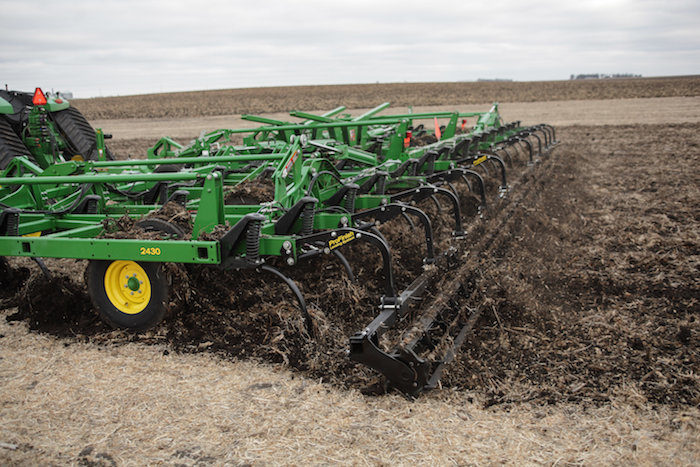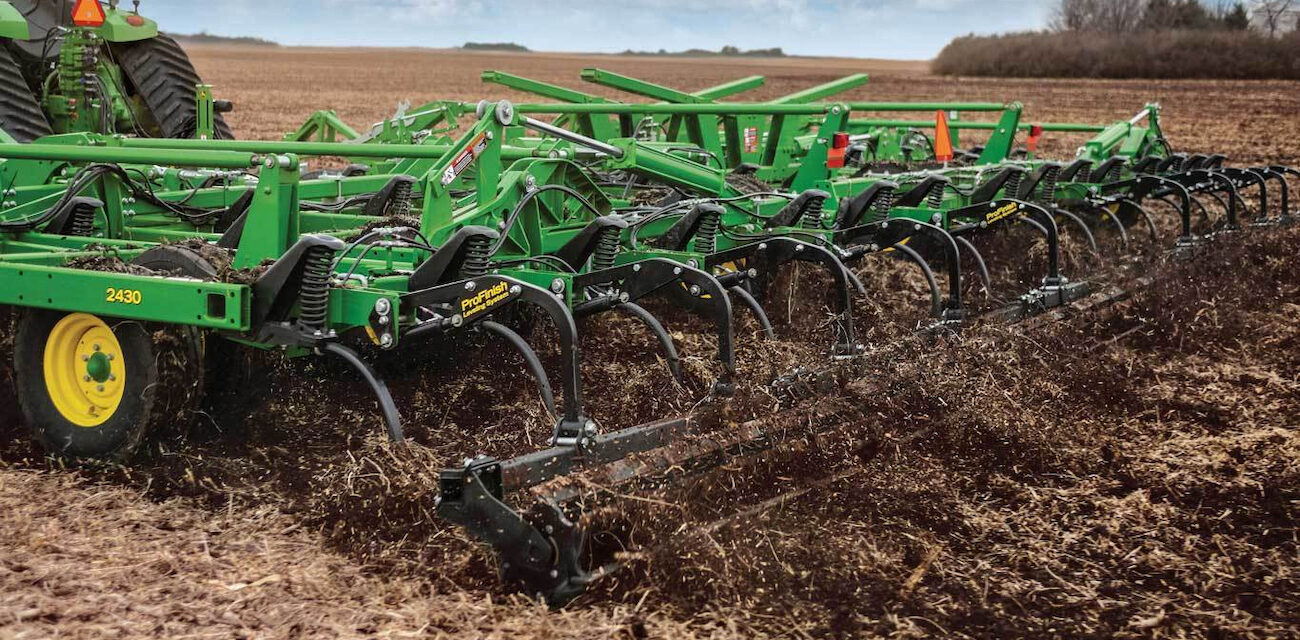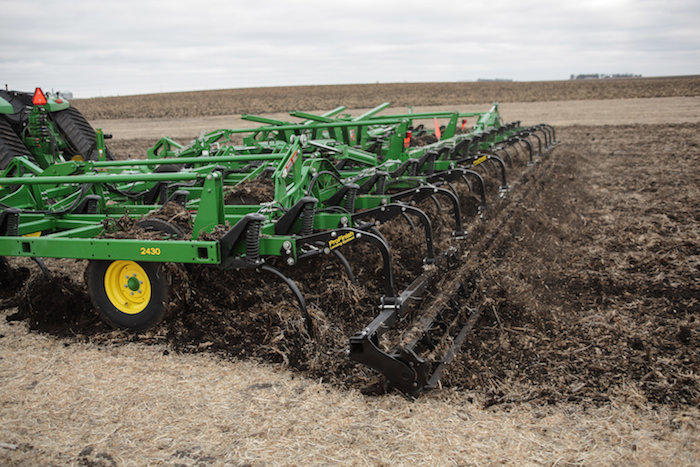Are you curious about how deep a chisel plow can go? Well, look no further because we’re about to dig into the fascinating world of farming equipment! Picture this: you’re out in a field, ready to till the soil and prepare it for planting. But how deep should you go? That’s where the chisel plow comes in.
Now, you might be wondering, what exactly is a chisel plow? It’s a specialized farm implement that’s used to break up compacted soil and create furrows for planting. But here’s the kicker: the depth it can reach depends on a few factors, like soil type and the specific model of the chisel plow.
So, buckle up and get ready to unearth the answers to all your burning questions about chisel plows and their depth capabilities. By the end of this article, you’ll be armed with the knowledge to tackle any chisel plow-related challenge that comes your way!
A chisel plow can dig to varying depths depending on soil conditions and the settings of the equipment. Generally, it can penetrate the soil up to 8-12 inches. However, factors like soil moisture, hardness, and the horsepower of the tractor can impact depth. It’s best to start with a shallow setting and gradually increase depth if needed. Remember to adjust the plow according to your specific soil conditions for optimal results.

How Deep Will a Chisel Plow Go?
When it comes to agricultural practices, understanding the capabilities and limitations of different tools and machinery is crucial. One such tool is the chisel plow, which is commonly used for tillage purposes. Farmers and agricultural enthusiasts often wonder: how deep will a chisel plow go? In this article, we will delve into the depths that a chisel plow can reach and explore the factors that influence its performance.
The Basics of a Chisel Plow
Before we explore the depth capabilities of a chisel plow, let’s first understand what it is. A chisel plow is an implement that consists of multiple shanks or tines attached to a frame. These shanks are designed to penetrate the soil and break it apart, creating a loose and friable seedbed. Unlike traditional moldboard plows that invert the soil layers, a chisel plow leaves residue on the surface, helping with erosion control and moisture conservation. The depth at which a chisel plow can operate depends on several factors.
One of the key factors that determine the depth of a chisel plow is the size and design of the shanks. Chisel plows come in various sizes, with shanks ranging from 12 to 20 inches in length. The longer the shanks, the deeper the plow can go. Additionally, the angle of the shanks also plays a role. Some chisel plows have adjustable shank angles, allowing farmers to customize the depth of operation.
Factors Influencing the Depth
While the design of the chisel plow is important, there are several other factors that influence the depth at which it can operate. One crucial factor is the soil type. Different soil types have varying levels of compaction and resistance. Hard, compacted soils may require more power and force to penetrate, limiting the depth capabilities of the chisel plow. On the other hand, loose and sandy soils allow for easier penetration, enabling the plow to reach greater depths.
Another factor to consider is the moisture content of the soil. Moisture affects soil consistency and can make it easier or harder for the chisel plow to penetrate. Dry soils are often more compacted and harder, requiring more effort to reach deeper depths. Conversely, moist soils are softer and more pliable, allowing the plow to go deeper.
The tractor’s horsepower also plays a significant role in determining the maximum depth a chisel plow can reach. A more powerful tractor can provide the necessary force to overcome resistance and drive the plow deeper into the soil. It is important to match the tractor’s horsepower to the size and requirements of the chisel plow for optimum performance.
Tips for Maximizing Chisel Plow Depth
While the design and factors mentioned above dictate the maximum depth a chisel plow can achieve, there are a few tips that farmers can employ to maximize its performance:
- Ensure the chisel plow is properly calibrated and adjusted. This includes setting the correct shank angle, depth, and spacing.
- Take soil conditions into account. Assess the moisture content and compaction levels before operating the chisel plow to determine the appropriate depth settings for optimal performance.
- Choose the right chisel plow for the specific soil type and conditions on the farm. Different models and designs cater to different soil types, ensuring better results.
- Regularly maintain and sharpen the shanks to ensure their efficiency and longevity.
- Consider using precision farming techniques, such as GPS guidance systems, to ensure consistent depth and coverage across the field.
The Benefits of Using a Chisel Plow
Now that we have explored the depth capabilities and factors influencing a chisel plow’s performance, let’s take a moment to highlight some of the benefits of using this tool in farming:
- Reduced soil erosion: Unlike moldboard plows that turn the soil over, chisel plows leave residue on the surface, protecting against erosion and preserving valuable topsoil.
- Improved moisture retention: The loose and friable seedbed created by the chisel plow allows for better water infiltration and retention, maximizing crop growth and quality.
- Increased organic matter: Leaving crop residue on the surface promotes the incorporation of organic matter into the soil, enriching its fertility and promoting healthy microbial activity.
- Enhanced root penetration: The chisel plow breaks up compacted layers, allowing crop roots to penetrate deeper into the soil and access vital nutrients and moisture.
Factors Affecting Chisel Plow Depth
In addition to the factors mentioned earlier, there are a few more key elements that can affect the depth at which a chisel plow can operate.
Soil Moisture Content
Soil moisture plays a significant role in determining how deep a chisel plow can go. It affects soil compaction and its ability to resist penetration. Dry soil tends to be harder and more compacted, making it more challenging for the chisel plow to reach deeper depths. On the other hand, moist soil is softer and more pliable, allowing for easier penetration and deeper operation.
It is important to note that soil moisture levels can vary throughout the field. Areas with better water retention and high organic matter content may have moister soil, allowing for deeper chisel plow operation. Farmers should assess soil moisture conditions and make any necessary adjustments to optimize performance.
Equipment Design
The design of the chisel plow itself is a crucial factor in determining the maximum depth it can reach. Chisel plows come in various models and sizes, each with its own advantages. The length and design of the shanks, along with the frame structure, influence the depth capabilities of the plow.
Longer shanks provide increased penetration and allow for deeper tillage. Additionally, the angle of the shanks can be adjusted to further customize the depth of operation. Farmers should choose a chisel plow that aligns with their specific requirements and field conditions to maximize depth potential.
Tractor Power
The tractor’s horsepower also plays a significant role in determining the depth at which a chisel plow can operate. A powerful tractor engine provides the necessary force to overcome resistance and drive the plow deeper into the soil. It is crucial to match the chisel plow’s requirements with the appropriate tractor power to ensure optimum performance and prevent any strain on the machinery.
Additionally, the tractor’s weight distribution and wheel configuration can affect the overall performance of the chisel plow. Proper weight distribution ensures consistent penetration and prevents excessive slippage, allowing the plow to reach its maximum potential depth.
Soil Type and Compaction
Soil type and compaction levels directly impact the depth capabilities of a chisel plow. Different soil types have varying levels of compaction and resistance. Hard, compacted soils require more power and force to penetrate, limiting the depth at which the plow can operate. Conversely, loose and sandy soils offer less resistance, allowing for deeper operation.
Prior knowledge of soil conditions and field history can guide farmers in selecting the appropriate chisel plow and making any necessary adjustments for optimal depth performance. Soil testing and analysis can provide valuable insights into soil compaction levels, enabling informed decisions when it comes to depth settings and operation.
Tips for Maximizing Chisel Plow Depth
To maximize the depth capabilities of a chisel plow and ensure optimal performance, consider the following tips:
Select the Right Chisel Plow
Take into account the specific requirements of your soil type and field conditions when selecting a chisel plow. Different models and designs cater to different needs and can offer varying depth capabilities. Consider consulting with agricultural experts or equipment dealers to find the most suitable option for your farm.
Set the Chisel Plow Correctly
Proper calibration and adjustment of the chisel plow are essential to achieving optimal depth performance. Set the shank angle, depth, and spacing according to the soil conditions and objectives. Refer to the manufacturer’s guidelines or seek advice from agricultural experts if unsure.
Monitor Soil Moisture Levels
Regularly monitor and assess soil moisture levels to understand how they may be impacting chisel plow performance. Adjust the depth settings as needed to accommodate variations in soil moisture content. Moisture probes or sensors can aid in gathering accurate data and make informed decisions.
Maintain and Sharpen the Shanks
Regular maintenance of the chisel plow is crucial to ensure its efficiency and longevity. Regularly inspect and sharpen the shanks to prevent dullness and maximize penetration capabilities. Replace any damaged or worn-out parts promptly. Well-maintained equipment performs better and allows for consistent depth operation.
Consider Precision Farming Techniques
Precision farming technologies, such as GPS guidance systems, can greatly enhance the accuracy and consistency of chisel plow depth across the field. Using these technologies ensures uniform tillage and reduces the risk of overworking or underworking certain areas. Explore the various precision farming options available and consider incorporating them into your chisel plow practices.
In Summary
The depth at which a chisel plow can operate depends on various factors, including the design of the plow, soil moisture content, tractor power, and soil type. While the maximum depth is influenced by these factors, farmers can maximize chisel plow performance by selecting the right equipment, setting it correctly, and maintaining the shanks. Monitoring soil moisture levels and considering precision farming techniques can further enhance depth capabilities. Understanding these factors and implementing the suggested tips will help farmers optimize the performance of their chisel plows and achieve the desired results in their agricultural practices.
Key Takeaways – How Deep Will a Chisel Plow Go?
1. A chisel plow is a type of tillage tool used in farming.
2. It is designed to break up soil and mix organic matter.
3. The depth that a chisel plow can go depends on factors like soil conditions and the type of chisel points being used.
4. Generally, a chisel plow can go up to 12 inches deep.
5. It is important to adjust the depth of the chisel plow according to the specific needs of the field.
Frequently Asked Questions
Are you curious about the depth a chisel plow can go? We’ve got you covered! Here are some commonly asked questions about the depth capabilities of chisel plows.
1. What factors determine how deep a chisel plow can go?
Several factors come into play when determining the depth a chisel plow can achieve. Soil type, moisture content, and the tractor’s horsepower play significant roles. Additionally, the design and condition of the chisel points or blades will affect the plow’s depth.
Proper adjustment of hydraulic control settings and the angle of the points or blades can also contribute to the plow’s depth capabilities. It’s essential to consider all these factors when aiming for a specific depth during chisel plowing.
2. Can a chisel plow reach deeper depths than other types of plows?
Yes, compared to other traditional plows, a chisel plow can typically reach greater depths. Its design allows for deeper penetration into the soil, breaking up compacted layers to improve drainage and root penetration. While other plows may have limitations, the chisel plow’s shanks or tines are designed to go deep.
However, it’s important to note that the desired depth should depend on the specific soil condition, crop requirements, and weed management strategies. Deep chisel plowing might not always be necessary or beneficial in every situation.
3. What is the maximum depth a chisel plow can achieve?
The maximum depth a chisel plow can achieve depends on various factors. In general, chisel plows can reach depths of 10 to 15 inches. However, with certain modifications and adjustments, some chisel plows can go even deeper, up to 20 inches or more.
It’s crucial to assess the soil conditions, taking into account factors such as soil moisture, compaction, and the ground’s ability to withstand deep tillage. Consulting with local agricultural experts or equipment manufacturers can help determine the appropriate depth for your specific situation.
4. Are there any limitations on how deep a chisel plow can go?
While chisel plows are capable of going deep, there are limitations. Soil conditions, such as hardpan layers or rocky soil, can restrict the depth a chisel plow can achieve. It’s essential to assess the soil structure and adjust the plow’s settings accordingly.
Additionally, the chisel plow’s design and horsepower of the tractor can also limit the maximum achievable depth. It’s crucial to have well-maintained equipment and choose the appropriate chisel point or blade design for the desired depth and soil conditions.
5. Does the chisel plow depth affect soil structure and fertility?
Yes, chisel plow depth can impact soil structure and fertility. Deep chisel plowing can help alleviate compaction and improve soil drainage by breaking up compacted layers. This allows plant roots to penetrate deeper into the soil and access nutrients and water more effectively.
However, deep tillage may also disrupt the natural soil structure, leading to increased erosion potential. It’s important to balance the benefits of deep tillage with the potential risks and soil conservation practices. Conservation tillage methods that preserve surface residues and minimize soil disturbance may be more appropriate in certain situations.

Summary
So, how deep can a chisel plow go? Well, it really depends on a few factors. Firstly, the type of soil plays a big role. Hard and compacted soil may limit the depth, while loose and soft soil allows for deeper penetration. Additionally, the condition of the chisel plow itself can affect how deep it can go. If the blades are sharp and in good shape, it can go deeper. Lastly, the power of the tractor pulling the chisel plow also matters. A more powerful tractor can handle deeper depths. Overall, it’s important to consider these factors to determine the maximum depth a chisel plow can achieve.
In conclusion, the depth a chisel plow can go depends on the type of soil, the condition of the plow, and the power of the tractor. It is essential to assess these factors to achieve the desired depth for effective soil management and crop cultivation. Happy plowing!
